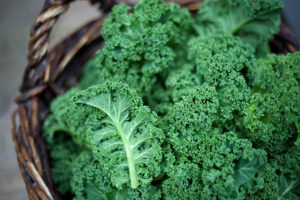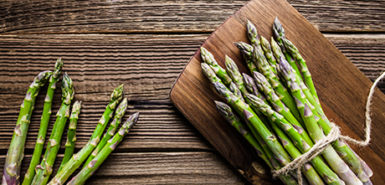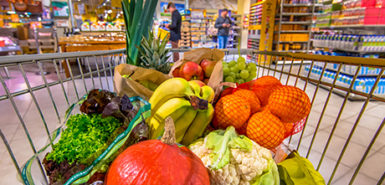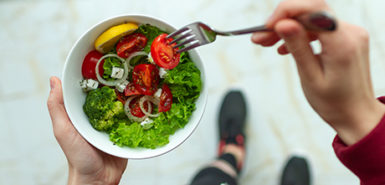
There’s no better time than summer to eat more fresh fruits and veggies.
Whether you plant your own garden, enjoy the array of in-season local produce at a farmer’s market, join a community-supported agriculture farm, or venture out for you-pick berries at a local farm—the possibilities are endless.
But sometimes we like the idea of eating more veggies, and we don’t know where to start.
Spectrum Health dietitian Angela Fobar is here with three nutrient-packed and delicious veggies to try today—along with easy instructions for how to get started.
1. Kale
It’s true: kale makes some people nervous.
Some find it bitter. Some have never tried it but assume they won’t like it. And some simply don’t know what to do with it.
But if there’s one veggie Fobar would love for you to try this summer, it’s kale. Considered a cruciferous vegetable (like broccoli, cauliflower and cabbage), it packs so much nutritional power that it’s often called a super-veggie.
Among the benefits of cruciferous vegetables like kale, Fobar said, is that they may reduce your risk of getting cancer, reduce inflammation in your body, may help lower your risk of cardiovascular disease, and contain valuable nutrients including vitamin A, vitamin C and folic acid.
So, where do you start with incorporating kale into your diet?
“People don’t realize the diversity of cooking with kale,” Fobar said. “It can be used anywhere. Even if you don’t love it as a star, you can still use it in a lot of different ways.”
To start, Fobar said, cut off the leaves and discard the stem.
Then, you can chop the leaves up small and mix them with a green salad or a grain salad (such as quinoa or farro). If you want to use kale as a main ingredient in a salad, Fobar suggested coating it with olive oil, to help break down the leaves and make it soft, versus bitter and chewy.
You can also add kale to soups, smoothies and omelettes.
To make it the star of a dish, roast kale chips or simply sauté it on the stove top with olive oil, salt, pepper and freshly squeezed lemon juice, Fobar said.
2. Brussels sprouts
Many people think they hate brussels sprouts, Fobar said, because they might have been served the boiled, bitter version many home cooks prepared in the past.
“There’s a reason for that,” Fobar said. “When you boil them, it releases the sulfur which gives it a bitter flavor. That goes away if you cook them properly.”
Better ways to prepare brussels sprouts include roasting or broiling them in the oven or sautéing them in a pan. You may want to slice them in half, giving them more exposure to the heat, she said. You also can shave raw brussels sprouts on top of a salad.
And don’t be afraid to season, perhaps with olive oil, spices, honey or maple syrup.
“When we’re trying new things or getting kids to be more adventurous, it’s important to use seasoning,” she said. “Not that we need to go crazy with butter or excessive amounts of cheese, but don’t be afraid to season.”
Instead of turning to the salt shaker, salt-free versions of vegetable seasoning are available in the spice aisle at the grocery store, and you can sprinkle them on just about anything, Fobar said. You can also make your own at home.
3. Zucchini
This vegetable is probably familiar to most, but Fobar said it’s soared to new heights lately with the spiralized version, called zoodles. That’s right—zucchini noodles.
“People are getting more comfortable with zoodles as a noodle replacement,” Fobar said. “They taste great, and they can be a lot of fun that way.”
Another use for zucchini is to shave it and freeze it to use as an ingredient in bread to lower the carb content. For roasting in the oven, cut it into strips and sprinkle with lemon pepper seasoning, Fobar suggested. Or coat it in panko bread crumbs, drizzle with olive oil and bake.
And here’s a Fobar family favorite (yes, her kids love it): zucchini pizzas.
“Another thing you can do if your zucchini gets really large, which always happens because it seems to grow overnight, is to slice it into coins,” she said. “Put pizza sauce on the coins choose other fun toppings.”
Then, roast it in the oven for delicious mini pizzas.
“We want our kids eating more veggies, and those are a really fun way to get excited about veggies,” she said.
The more veggies, the better
Fobar also reminds everyone this summer, when they might not want to turn on the oven or stovetop, to remember that raw vegetables are great.
“The most nutritional form is when we do eat them raw,” she said. “Go for those raw veggies.”
Carrots, cauliflower, broccoli, cucumbers, celery, tomatoes, peppers and more are all great served raw.
“Peppers are probably one of my favorite ones,” she said. “They’re very sweet and likeable.”
They also have more vitamin C than even some citrus fruits. One medium-sized pepper has 169% of an adult’s daily recommended amount of vitamin C.
Fobar leaves you with another family favorite summertime treat: watermelon pizza on the grill. Slice your watermelon like a round pizza slice and grill it. Remove from the grill and top it with tomatoes, feta cheese and balsamic glaze—or anything that sounds good to you. Serve it as a side or dessert.
She encourages everyone to find their own ways to boost their intake of summer veggies—and remember, when it comes to veggies, more is always better.
 /a>
/a>
 /a>
/a>
 /a>
/a>
Your blog is exceptionally informative. You give a lot of information about green veggies and how we can utilize those in numerous ways. We all know everyone likes junk food but it is not good for our health. Few months ago,my brother fell ill. By the regular eating of junk foods he had gained weight and at that time the doctor said that many health related issues he had to face at that time. Then he went to an expert and they suggested that he can only eat green leafy veggies and fruits and do exercise daily, with this they also suggested that he have to get tested regularly or go for daycare. To determine your health issues. With this prescription, he overcomes those issues.